The Effects of Electrochemical Hydrogen Charging on Charpy Impact Toughness and Dry Sliding Tribological Behavior of AISI 316H Stainless Steel
Abstract
:1. Introduction
2. Experimental Materials and Methods
3. Results and Discussion
3.1. Microstructure of Solution-Annealed Material
3.2. Determination of Absorbed Hydrogen
3.3. Effect of Hydrogen Charging on CVN Impact Toughness
3.4. Effect of Hydrogen Charging on Tribological Behavior
4. Summary and Conclusions
- The EBSD crystallographic phase analyses indicated that the applied electrochemical hydrogen charging and subsequent dynamic loading tests did not result in any phase transformations of the studied austenitic steel at room temperature.
- The used electrochemical hydrogen charging of investigated material resulted in a slight increase in both the CVN impact toughness and COF frictional coefficient. At the same time, the specific wear rate of electrochemically hydrogenated material exhibited a slight decrease compared to the non-hydrogenated material.
- The observed slight improvement in the CVN impact toughness of electrochemically hydrogenated AISI 316H steel is mainly related to the hydrogen-enhanced twinning-induced plasticity mechanism. However, owing to rather small changes in CVN impact toughness due to hydrogen charging, the hydrogenation effects on microstructural and fractographic characteristics were rather negligible in comparison with non-hydrogenated material.
- The COF increase in hydrogenated material could be ascribed to the local overheating of the tribological surface due to decreased thermal conductivity in the presence of hydrogen. This conclusion can be supported by the observed transition of the acting wear mechanism from pure abrasive wear for non-hydrogenated material to the more complex abrasion/adhesion wear mechanism for the hydrogen-charged material. These changes in specific wear rates for individual material states also correlate well with observed changes in acting wear mechanisms.
- Both CVN impact toughness tests and dry linear sliding tests performed on the dehydrogenated materials indicated their reversible behavior leading to the restoration of nearly original properties. On the whole, it can be concluded that the observed hydrogen-induced changes in individual properties determined under dynamic loading conditions indicated the high resistance of studied solution-annealed AISI 316H steel against material degradation in currently performed electrolytic hydrogen-charging experiments.
Author Contributions
Funding
Data Availability Statement
Acknowledgments
Conflicts of Interest
References
- Simon, F. EU Commission Unveils ‘European Green Deal’: The Key Points. Available online: https://www.euractiv.com/section/energy-environment/news/eu-commission-unveils-european-green-deal-the-key-points/ (accessed on 12 June 2023).
- Kušnírová, K.; Varcholová, D.; Molčanová, Z.; Ballóková, B.; Möllmer, J.; Jasminská, N.; Lazár, M.; Brestovič, T.; Podobová, M.; Džunda, R.; et al. Multicomponent metal alloys tested for hydrogen storage. In Proceedings of the 31st International Conference on Metallurgy and Materials, Metal 2022, Brno, Czech Republic, 18–19 May 2022; pp. 339–344, Code 184827. [Google Scholar] [CrossRef]
- Gérard, F.; Van Nuffel, L.; Smit, T.; Yearwood, J.; Černý, O.; Michalski, J.; Altmann, M. Opportunities for Hydrogen Energy Technologies Considering the National Energy & Climate Plans. Trinomics B.V. Final Report. FCH 2 JU. 2020. Available online: https://trinomics.eu/wp-content/uploads/2020/09/Final-Report-Hydrogen-in-NECPs.pdf (accessed on 12 June 2023).
- Akhtar, M.S.; Khan, H.; Liu, J.J.; Na, J. Green hydrogen and sustainable development—A social LCA perspective highlighting social hotspots and geopolitical implications of the future hydrogen economy. J. Clean. Prod. 2023, 395, 136438. [Google Scholar] [CrossRef]
- Tashie-Lewis, B.C.; Nnabuife, S.G. Hydrogen Production, Distribution, Storage and Power Conversion in a Hydrogen Economy—A Technology Review. Chem. Eng. J. Adv. 2021, 8, 100172. [Google Scholar] [CrossRef]
- Dawood, F.; Anda, M.; Shafiullah, G.M. Hydrogen production for energy: An overview. Int. J. Hydrog. Energy 2020, 45, 3847–3869. [Google Scholar] [CrossRef]
- Johnson, W.H. On some remarkable changes produced in iron and steel by the action of hydrogen and acids. Proc. R. Soc. Lond. 1875, 23, 168–179. [Google Scholar] [CrossRef]
- Padhy, G.K.; Komizo, Y.I. Diffusible Hydrogen in Steel Weldments-A Status Review. Trans. JWRI 2013, 42, 39–62. [Google Scholar] [CrossRef]
- Dwivedi, S.K.; Vishwakarma, M. Hydrogen embrittlement in different materials: A review. Int. J. Hydrog. Energy 2018, 43, 21603–21616. [Google Scholar] [CrossRef]
- Depover, T.; Verbeken, K. The detrimental effect of hydrogen at dislocations on the hydrogen embrittlement susceptibility of Fe-C-X alloys: An experimental proof of the HELP mechanism. Int. J. Hydrog. Energy 2018, 43, 3050–3061. [Google Scholar] [CrossRef]
- Liu, Q.; Venezuela, J.; Zhang, M.; Zhou, Q.; Atrens, A. Hydrogen trapping in some advanced high strength steels. Corros. Sci. 2016, 111, 770–785. [Google Scholar] [CrossRef] [Green Version]
- Seo, H.J.; Kim, N.M.; Jo, J.W.; Lee, C.S. Effect of tempering duration on hydrogen embrittlement of vanadium-added tempered martensitic steel. Int. J. Hydrog. Energy 2021, 46, 19670–19681. [Google Scholar] [CrossRef]
- Hagihara, Y.; Shobu, T.; Hisamori, N.; Suzuki, H.; Takai, K.; Hirai, K. Delayed Fracture Using CSRT and Hydrogen Trapping Characteristics of V-bearing High-strength Steel. ISIJ Int. 2012, 52, 298–306. [Google Scholar] [CrossRef] [Green Version]
- Escobar, D.P.; Verbeken, K.; Duprez, L.; Verhaege, M. Evaluation of hydrogen trapping in high strength steels by thermal desorption spectroscopy. Mater. Sci. Eng. A 2012, 551, 50–58. [Google Scholar] [CrossRef]
- Hadžipašić, A.B.; Malina, J.; Malina, M. The influence of microstructure on hydrogen diffusion and embrittlement of fine-grained high strength dual-phase steels. Kov. Mater. 2021, 59, 69–78. [Google Scholar] [CrossRef]
- Bai, S.; Liu, L.; Liu, C.; Xie, C. Phase-Field Insights into Hydrogen Trapping by Secondary Phases in Alloys. Materials 2023, 16, 3189. [Google Scholar] [CrossRef] [PubMed]
- Moshtaghi, M.; Safyari, M.; Mori, G. Combined thermal desorption spectroscopy, hydrogen visualization, HRTEM and EBSD investigation of a Ni–Fe–Cr alloy: The role of hydrogen trapping behavior in hydrogen-assisted fracture. Mater. Sci. Eng. A 2022, 848, 143428. [Google Scholar] [CrossRef]
- Toribio, J.; Lorenzo, M.; Aguado, L. Innovative Design of Residual Stress and Strain Distributions for Analyzing the Hydrogen Embrittlement Phenomenon in Metallic Materials. Materials 2022, 15, 9063. [Google Scholar] [CrossRef]
- Čiripová, L.; Falat, L.; Homolová, V.; Džupon, M.; Džunda, R.; Dlouhý, I. The Effect of Electrolytic Hydrogenation on Mechanical Properties of T92 Steel Weldments under Different PWHT Conditions. Materials 2020, 13, 3653. [Google Scholar] [CrossRef]
- Ševc, P.; Falat, L.; Čiripová, L.; Džupon, M.; Vojtko, M. The Effects of Electrochemical Hydrogen Charging on Room-Temperature Tensile Properties of T92/TP316H Dissimilar Weldments in Quenched-and-Tempered and Thermally-Aged Conditions. Metals 2019, 9, 864. [Google Scholar] [CrossRef] [Green Version]
- Falat, L.; Čiripová, L.; Homolová, V.; Kroupa, A. The influence of isothermal ageing and subsequent hydrogen charging at room temperature on local mechanical properties and fracture characteristics of martensitic-bainitic weldments for power engineering. J. Min. Metall. Sect. B-Metall. 2017, 53, 373–382. [Google Scholar] [CrossRef] [Green Version]
- Falat, L.; Čiripová, L.; Homolová, V.; Futáš, P.; Ševc, P. Hydrogen pre-charging effects on the notch tensile properties and fracture behaviour of heat-affected zones of thermally aged welds between T24 and T92 creep-resistant steels. Kov. Mater. 2016, 54, 417–427. [Google Scholar] [CrossRef] [Green Version]
- Blach, J.; Falat, L. The influence of thermal exposure and hydrogen charging on the notch tensile properties and fracture behaviour of dissimilar T91/TP316H weldments. High Temp. Mater. Proc. 2014, 33, 329–337. [Google Scholar] [CrossRef]
- Blach, J.; Falat, L.; Ševc, P. The influence of hydrogen charging on the notch tensile properties and fracture behaviour of dissimilar weld joints of advanced Cr–Mo–V and Cr–Ni–Mo creep-resistant steels. Eng. Fail. Anal. 2011, 18, 485–491. [Google Scholar] [CrossRef]
- Falat, L.; Čiripová, L.; Petryshynets, I.; Milkovič, O.; Džupon, M.; Kovaľ, K. Hydrogen Embrittlement Behavior of Plastically Pre-Strained and Cathodically Hydrogen-Charged 316H Grade Austenitic Stainless Steel. Crystals 2022, 12, 1419. [Google Scholar] [CrossRef]
- Zhou, Y.; Zhou, D.; Jin, X.; Zhang, L.; Du, X.; Li, B. Design of non-equiatomic medium-entropy alloys. Sci. Rep. 2018, 8, 1236. [Google Scholar] [CrossRef] [Green Version]
- Yan, M.; Weng, Y. Study on hydrogen absorption of pipeline steel under cathodic charging. Corros. Sci. 2006, 48, 432. [Google Scholar] [CrossRef]
- Ozdirik, B.; Baert, K.; Depover, T.; Vereecken, J.; Verbeken, K.; Terryn, H.; De Graeve, I. Development of an Electrochemical Procedure for Monitoring Hydrogen Sorption/Desorption in Steel. J. Electrochem. Soc. 2017, 164, C747–C757. [Google Scholar] [CrossRef]
- Capelle, J.; Gilgert, J.; Dmytrakh, I.; Pluvinage, G. Sensitivity of pipelines with steel API X52 to hydrogen embrittlement. Int. J. Hydrog. Energy 2008, 33, 7630–7641. [Google Scholar] [CrossRef]
- Capelle, J.; Gilgert, J.; Pluvinage, G. A fatigue initiation parameter for gas pipe steel submitted to hydrogen absorption. Int. J. Hydrog. Energy 2010, 35, 833–843. [Google Scholar] [CrossRef]
- ISO 148-1:2016; Metallic Materials—Charpy Pendulum Impact Test—Part 1: Test Method. International Organization for Standardization: London, UK, 2016. Available online: https://www.iso.org/standard/63802.html (accessed on 14 May 2023).
- ASTM G133-05(2016); Standard Test Method for Linearly Reciprocating Ball-on-Flat Sliding Wear. ASTM International: West Conshohocken, PA, USA, 2016. Available online: https://www.astm.org/g0133-05r16.html (accessed on 14 May 2023).
- Walton, W. Feret‘s Statistical Diameter as a Measure of Particle Size. Nature 1948, 162, 329–330. [Google Scholar] [CrossRef]
- Medved’, D.; Ivor, M.; Kovalčíková, A.; Múdra, E.; Csanádi, T.; Sedlák, R.; Ünsal, H.; Tatarko, P.; Tatarková, M.; Šajgalík, P.; et al. Wear behavior of (Mo–Nb–Ta–V–W)C high-entropy carbide. Int. J. Appl. Ceram. Technol. 2023, 20, 224–235. [Google Scholar] [CrossRef]
- Pearson, T. Calculation of the Amount of Hydrogen Absorbed by Steel During the Mechanical Plating Operation. MacDermid Industrial Solutions 4/2/2015. Available online: https://anochrome.com/wp-content/uploads/Embrittlement-in-Mech.pdf (accessed on 9 July 2023).
- Lovicu, G.; Bottazzi, M.; D’aiuto, F.; De Sanctis, M.; Dimatteo, A.; Santus, C.; Valentini, R. Hydrogen embrittlement of automotive advanced high-strength steels. Metall. Mater. Trans. A 2012, 43, 4075–4087. [Google Scholar] [CrossRef]
- Cho, S.; Kim, G.-I.; Ko, S.-J.; Yoo, J.-S.; Jung, Y.-S.; Yoo, Y.-H.; Kim, J.-G. Comparison of Hydrogen Embrittlement Susceptibility of Different Types of Advanced High-Strength Steels. Materials 2022, 15, 3406. [Google Scholar] [CrossRef]
- Luo, H.; Li, Z.; Raabe, D. Hydrogen enhances strength and ductility of an equiatomic high-entropy alloy. Sci. Rep. 2017, 7, 9892. [Google Scholar] [CrossRef] [Green Version]
- Feng, Z.; Li, X.; Song, X.; Gu, T.; Zhang, Y. Hydrogen Embrittlement of CoCrFeMnNi High-Entropy Alloy Compared with 304 and IN718 Alloys. Metals 2022, 12, 998. [Google Scholar] [CrossRef]
- Zhang, S.; Liu, M.; Luo, Y.; Wang, L.; Wang, Z.; Wang, Z.; Li, F.; Wang, X. Immunity of Al0.25CoCrFeNi high-entropy alloy to hydrogen embrittlement. Mater. Sci. Eng. A 2021, 821, 141590. [Google Scholar] [CrossRef]
- Mohammadi, A.; Novelli, M.; Arita, M.; Bae, J.W.; Kim, H.S.; Grosdidier, T.; Edalati, K. Gradient-structured high-entropy alloy with improved combination of strength and hydrogen embrittlement resistance. Corros. Sci. 2022, 200, 110253. [Google Scholar] [CrossRef]
- Pu, Z.; Chen, Y.; Dai, L.H. Strong resistance to hydrogen embrittlement of high-entropy alloy. Mater. Sci. Eng. A 2018, 736, 156–166. [Google Scholar] [CrossRef]
- Kwon, Y.J.; Won, J.W.; Park, S.-H.; Lee, J.H.; Lim, K.R.; Na, Y.S.; Lee, C.S. Ultrahigh-strength CoCrFeMnNi high-entropy alloy wire rod with excellent resistance to hydrogen embrittlement. Mater. Sci. Eng. A 2018, 732, 105–111. [Google Scholar] [CrossRef]
- Zhao, Y.; Lee, D.H.; Kim, W.J.; Seok, M.Y.; Kim, J.Y.; Han, H.N.; Suh, J.Y.; Ramamurty, U.; Jang, J.I. Influence of pre-strain on the gaseous hydrogen embrittlement resistance of a high-entropy alloy. Mater. Sci. Eng. A 2018, 718, 43–47. [Google Scholar] [CrossRef]
- Lai, Z.H.; Lin, Y.T.; Sun, Y.H.; Tu, J.F.; Yen, H.W. Hydrogen-induced ductilization in a novel austenitic lightweight TWIP steel. Scr. Mater. 2022, 213, 114629. [Google Scholar] [CrossRef]
- Murakami, Y.; Kanezaki, T.; Mine, Y. Hydrogen Effect against Hydrogen Embrittlement. Metall. Mater. Trans. A 2010, 41, 2548–2562. [Google Scholar] [CrossRef] [Green Version]
- Ueki, S.; Oura, R.; Mine, Y.; Takashima, K. Micro-mechanical characterisation of hydrogen embrittlement in nano-twinned metastable austenitic stainless steel. Int. J. Hydrog. Energy 2020, 45, 27950–27957. [Google Scholar] [CrossRef]
- Li, X.; Lu, G.; Wang, Q.; Zhao, J.; Xie, Z.; Misra, R.D.K.; Shang, C. The Effects of Prior Austenite Grain Refinement on Strength and Toughness of High-Strength Low-Alloy Steel. Metals 2022, 12, 28. [Google Scholar] [CrossRef]
- Li, X.; Zhao, J.; Dong, L.; Misra, R.D.K.; Wang, X.; Wang, X.; Shang, C. The Significance of Coherent Transformation on Grain Refinement and Consequent Enhancement in Toughness. Materials 2020, 13, 5095. [Google Scholar] [CrossRef]
- Park, M.; Kang, M.S.; Park, G.-W.; Choi, E.Y.; Kim, H.-C.; Moon, H.-S.; Jeon, J.B.; Kim, H.; Kwon, S.-H.; Kim, B.J. The Effects of Recrystallization on Strength and Impact Toughness of Cold-Worked High-Mn Austenitic Steels. Metals 2019, 9, 948. [Google Scholar] [CrossRef] [Green Version]
- Liao, J.; Hotta, M.; Kaneko, K.; Kondoh, K. Enhanced impact toughness of magnesium alloy by grain refinement. Scr. Mater. 2009, 61, 208–211. [Google Scholar] [CrossRef]
- Karthikeyan, T.; Thomas Paul, V.; Saroja, S.; Moitra, A.; Sasikala, G.; Vijayalakshmi, M. Grain refinement to improve impact toughness in 9Cr–1Mo steel through a double austenitization treatment. J. Nucl. Mater. 2011, 419, 256–262. [Google Scholar] [CrossRef]
- Zhang, W.; Dong, Z.H.; Shang, X.; Chen, S.G.; Zhang, L.J.; Peng, X. Enhancement of the strength-toughness balance in a quenched laser-additively-manufactured low alloy mild steel: Effect of grain refinement and nanotwin bundle formation. Mater. Sci. Eng. A 2023, 862, 144488. [Google Scholar] [CrossRef]
- Zhang, S.; Yang, M.; Wu, X.; Yuan, F. Superior fracture toughness with high yield strength in a high-Mn steel induced by heterogeneous grain structure. Mater. Des. 2023, 225, 111473. [Google Scholar] [CrossRef]
- Stavrovskaia, V.E.; Efremenko, V.G.; Zurnadzhy, V.I.; Zotov, D.S.; Sagirov, R.I.; Chabak Yu, G.; Brykov, M.N.; Efremenko, B.V. Effect of Chemical Composition and Normalization Parameters on Microstructure and Mechanical Properties of Microalloyed Sheet Steel for Structural Purposes. In Advances in Materials Science Research; Wythers, M.C., Ed.; Nova Science Publishers, Inc.: New York, NY, USA, 2022; Volume 55, ISBN 979-8-88697-213-9. [Google Scholar]
- Rahimi, R.; Biermann, H.; Volkova, O.; Mola, J. On the origin of subgrain boundaries during conventional solidification of austenitic stainless steels. IOP Conf. Ser. Mater. Sci. Eng. 2018, 373, 012005. [Google Scholar] [CrossRef]
- Ogawa, Y.; Nishida, H.; Takakuwa, O.; Tsuzaki, K. Hydrogen-enhanced deformation twinning in Fe-Cr-Ni-based austenitic steel characterized by in-situ EBSD observation. Mater. Today Commun. 2023, 34, 105433. [Google Scholar] [CrossRef]
- Nguyen, L.T.H.; Hwang, J.S.; Kim, M.S.; Kim, J.H.; Kim, S.K.; Lee, J.M. Charpy Impact Properties of Hydrogen-Exposed 316L Stainless Steel at Ambient and Cryogenic Temperatures. Metals 2019, 9, 625. [Google Scholar] [CrossRef] [Green Version]
- Ye, J.; Li, Z.; Zhang, L.; Wang, S.; Jiang, L. Measurement and the improvement of effective thermal conductivity for a metal hydride bed—A review. RSC Adv. 2022, 12, 25722. [Google Scholar] [CrossRef] [PubMed]
- Luo, M.; Jiang, D.; Liu, S.; Ouyang, C. Effect of Interstitial Hydrogen on the Mechanical and Thermal Properties of Tungsten: A First-Principles Study. J. Phys. Chem. C 2019, 123, 1913–1921. [Google Scholar] [CrossRef]
- Mittal, D.; Singh, D.; Kumar Sharma, S. Thermal Characteristics and Tribological Performances of Solid Lubricants: A Mini Review. In Advances in Rheology of Materials; Dutta, A., Ali, H.M., Eds.; IntechOpen: London, UK, 2023; Available online: https://www.intechopen.com/chapters/86047 (accessed on 19 July 2023).
- Roy, A.; Patel, P.; Sharifi, N.; Chromik, R.R.; Stoyanov, P.; Moreau, C. Binary and ternary lubricious oxides for high temperature tribological applications: A review. Results Surf. Interfaces 2023, 11, 100117. [Google Scholar] [CrossRef]

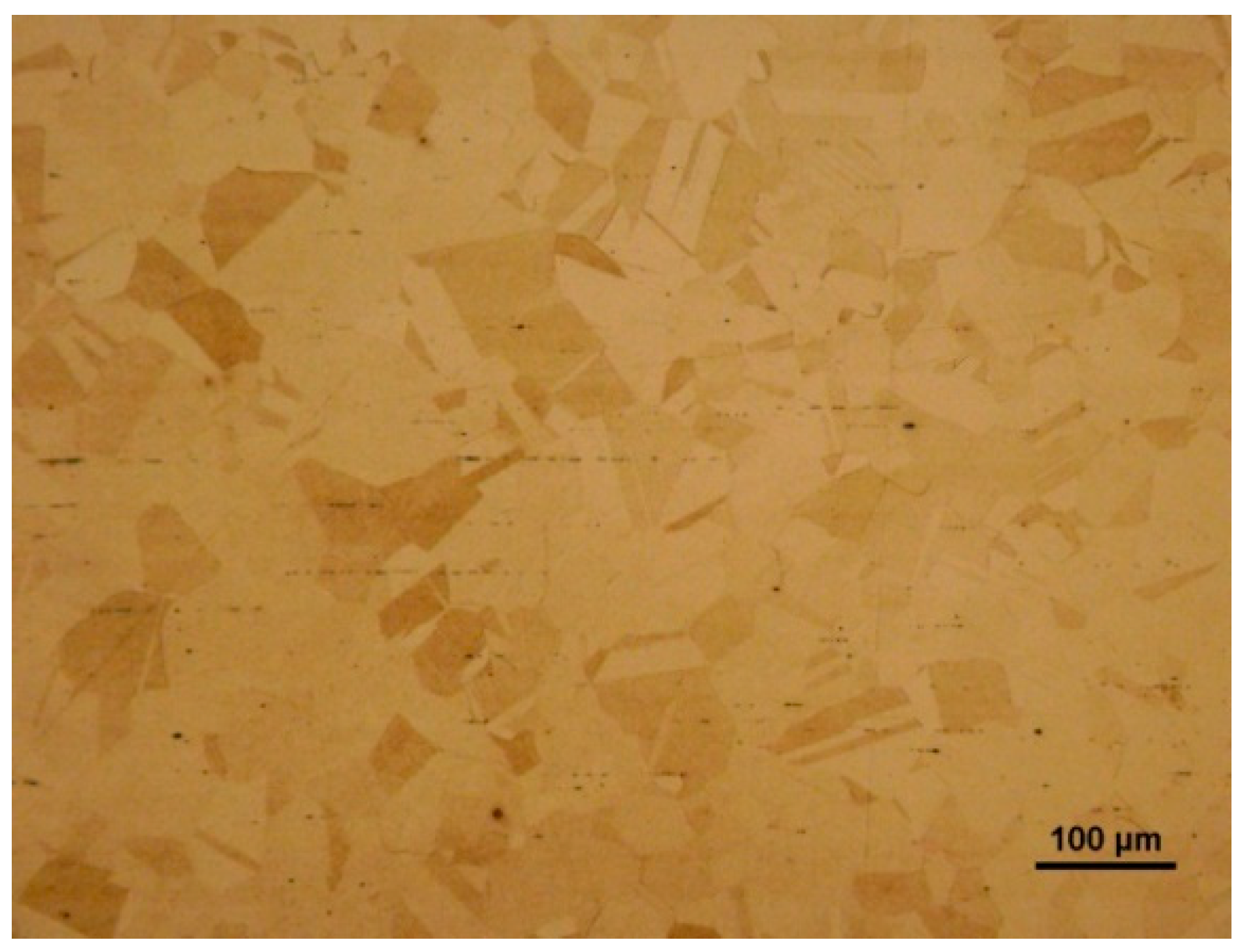

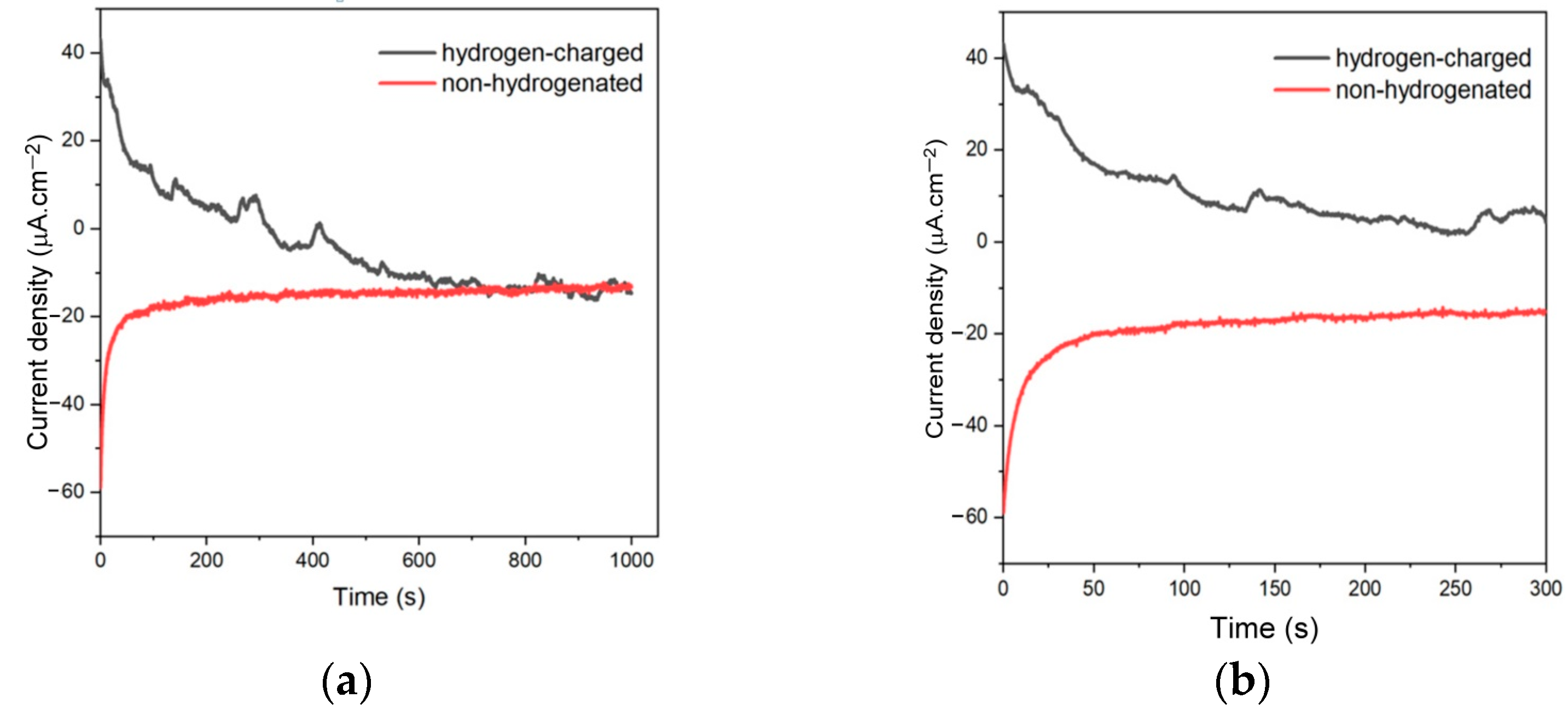
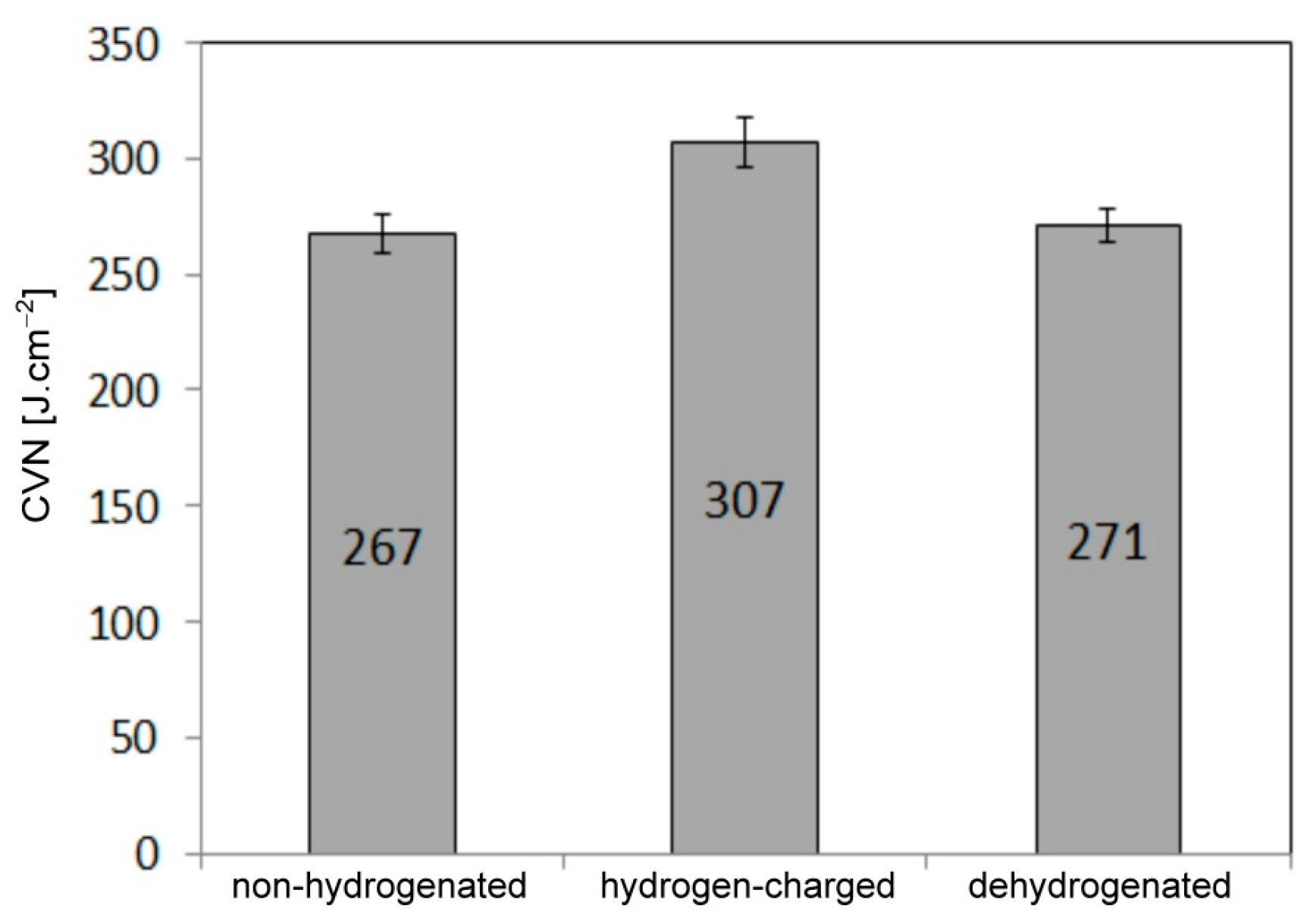
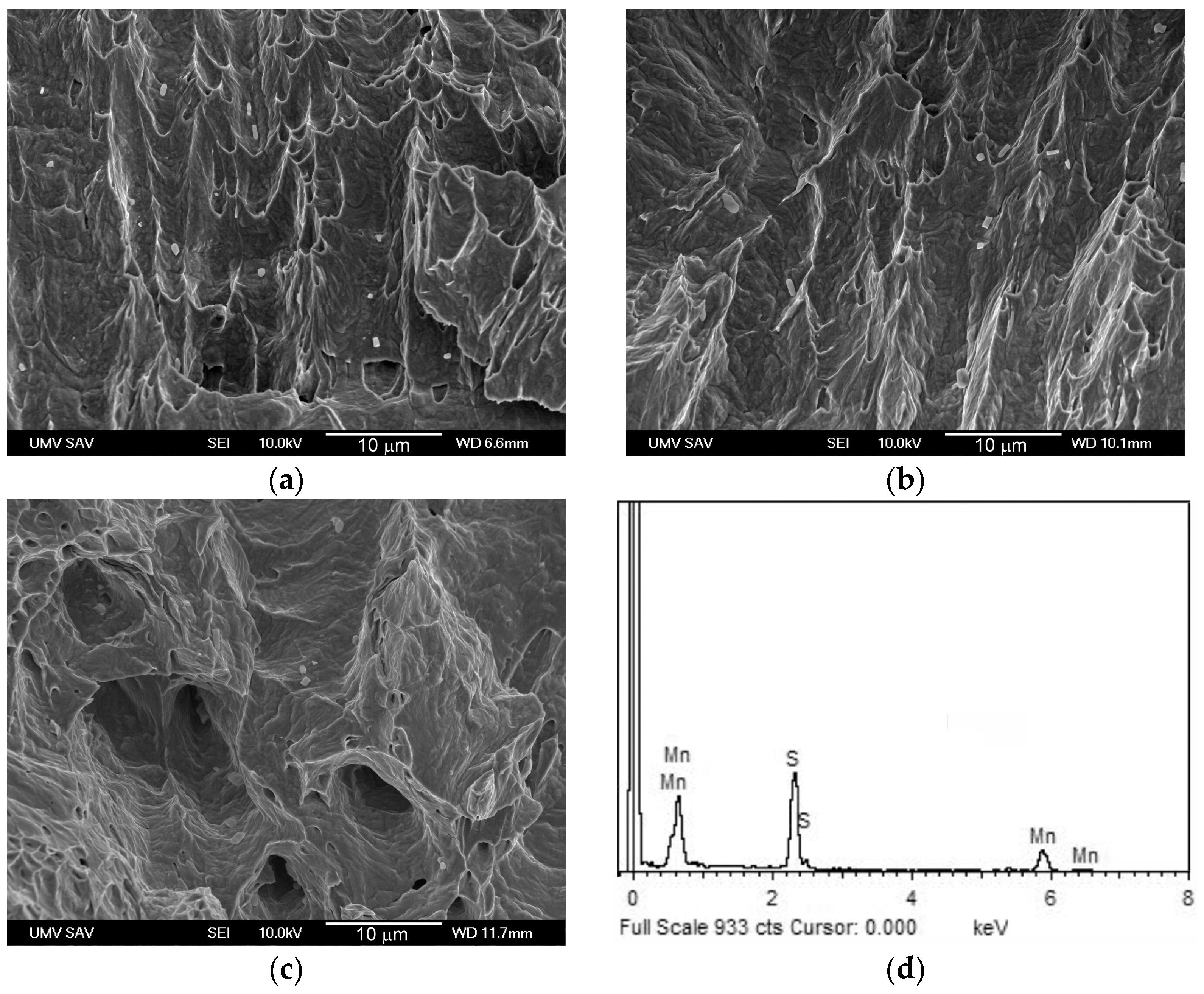
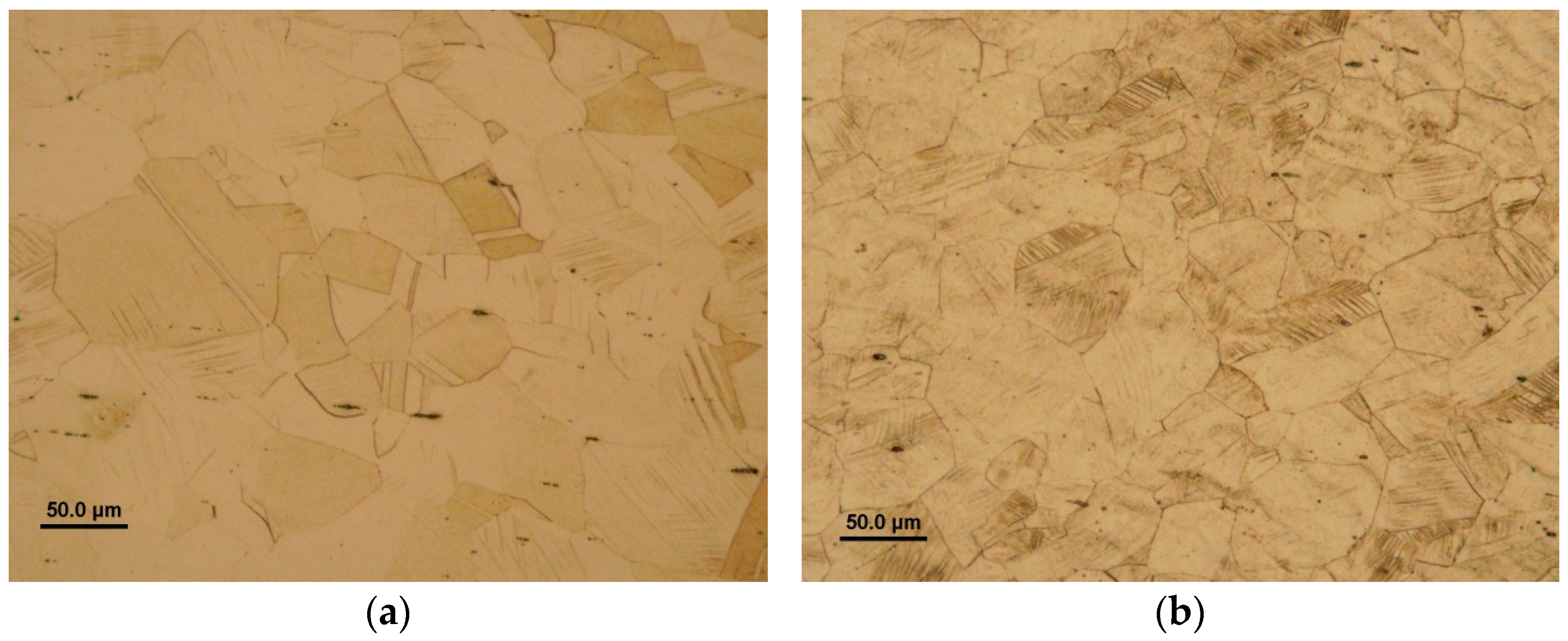
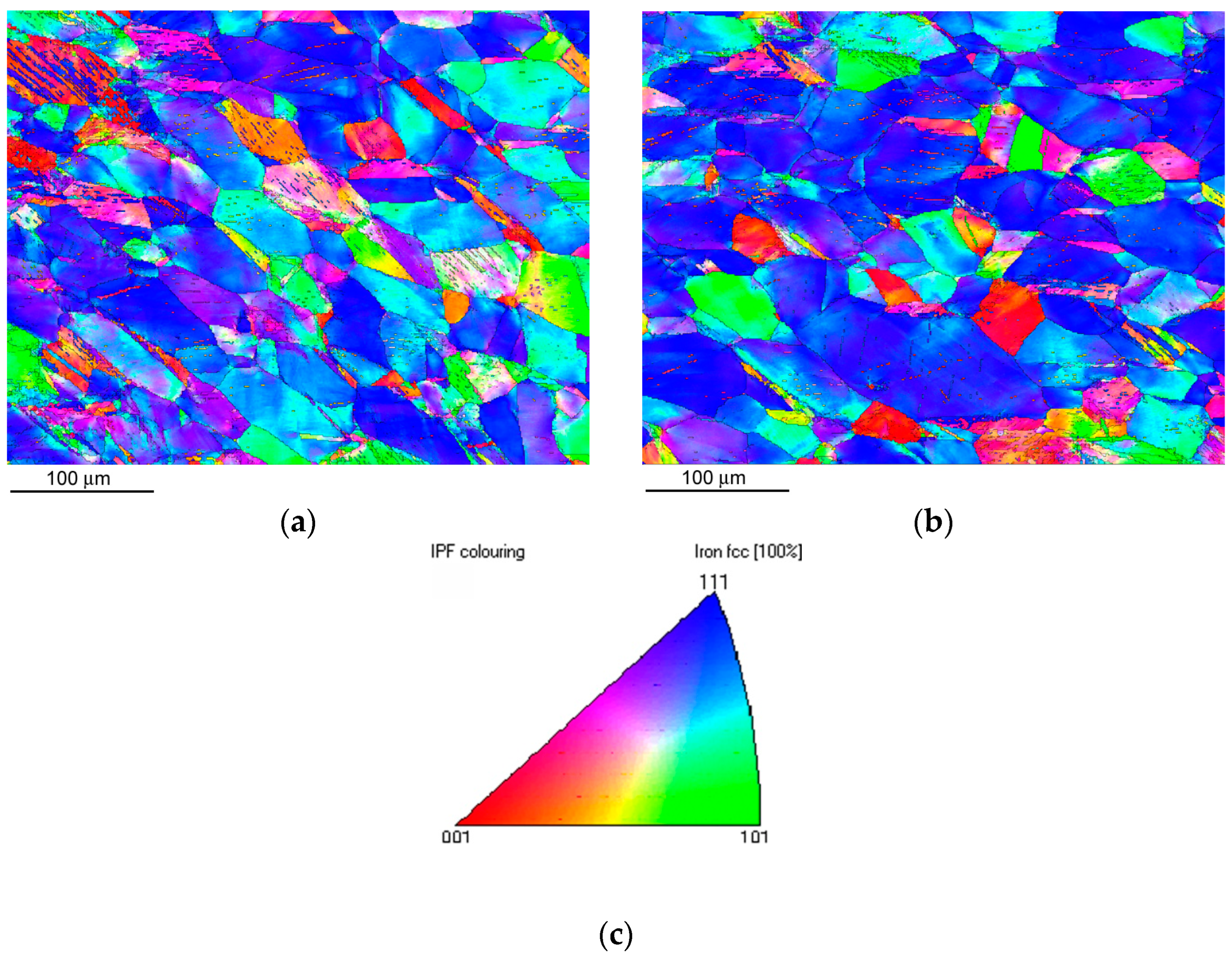
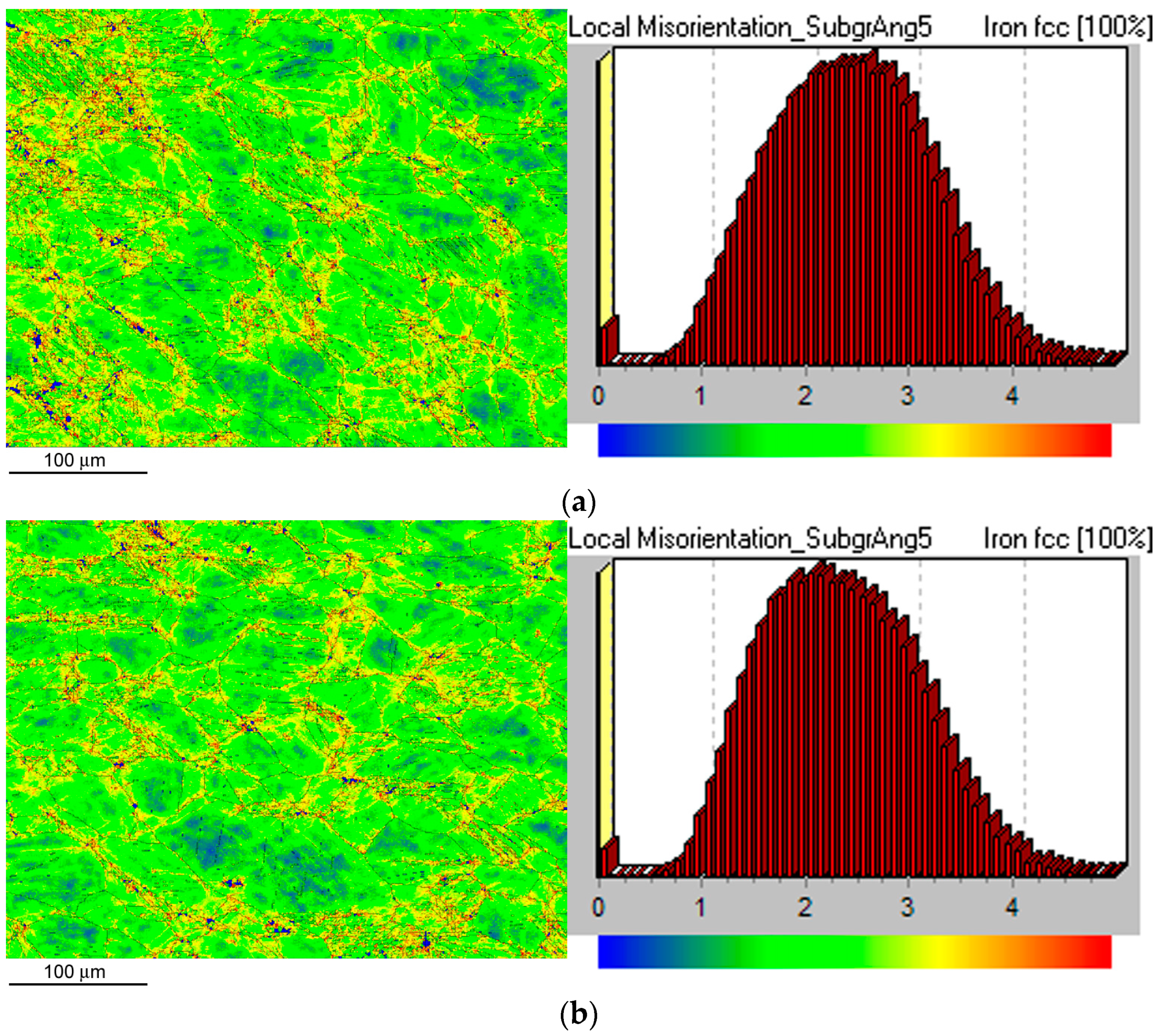
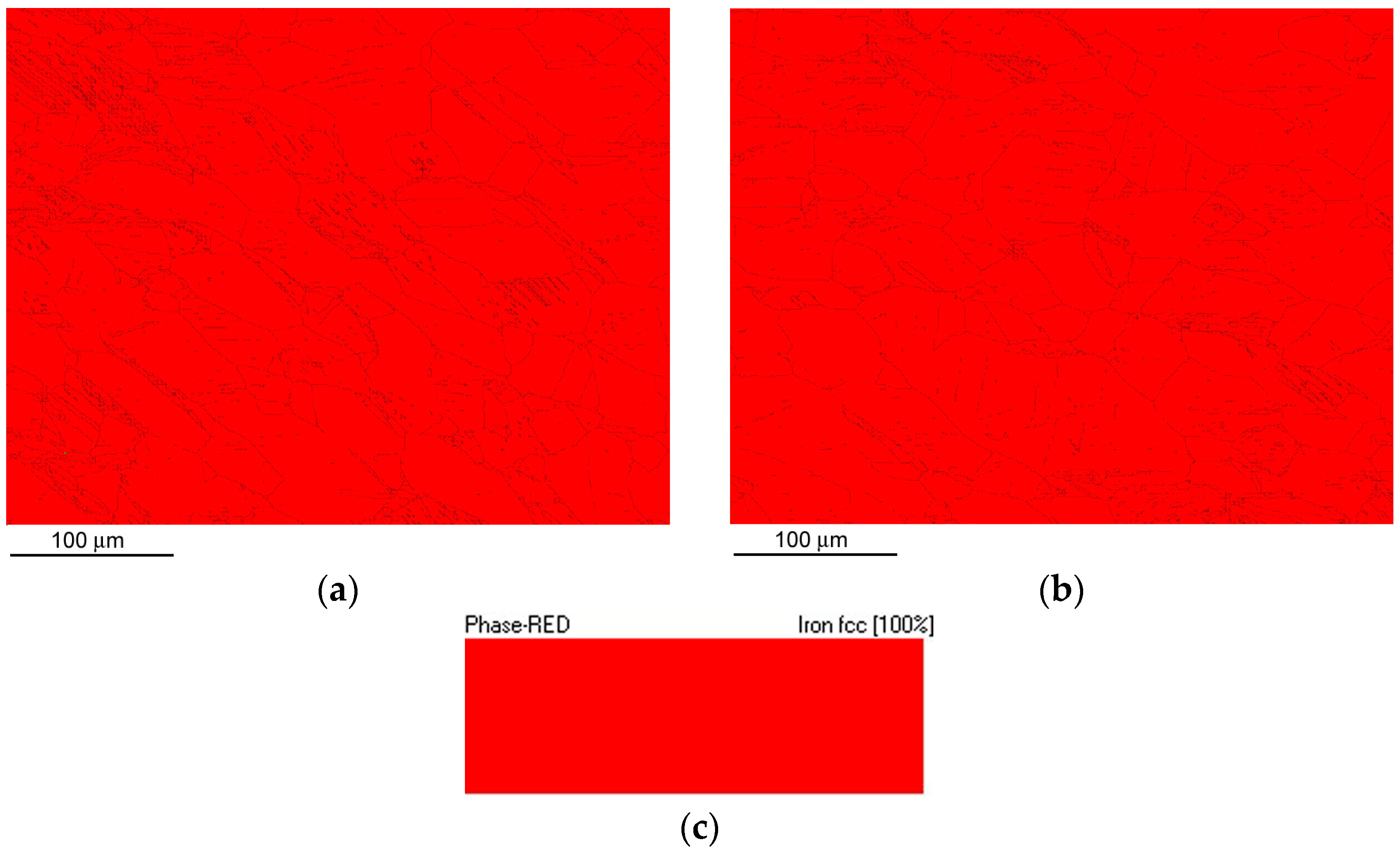
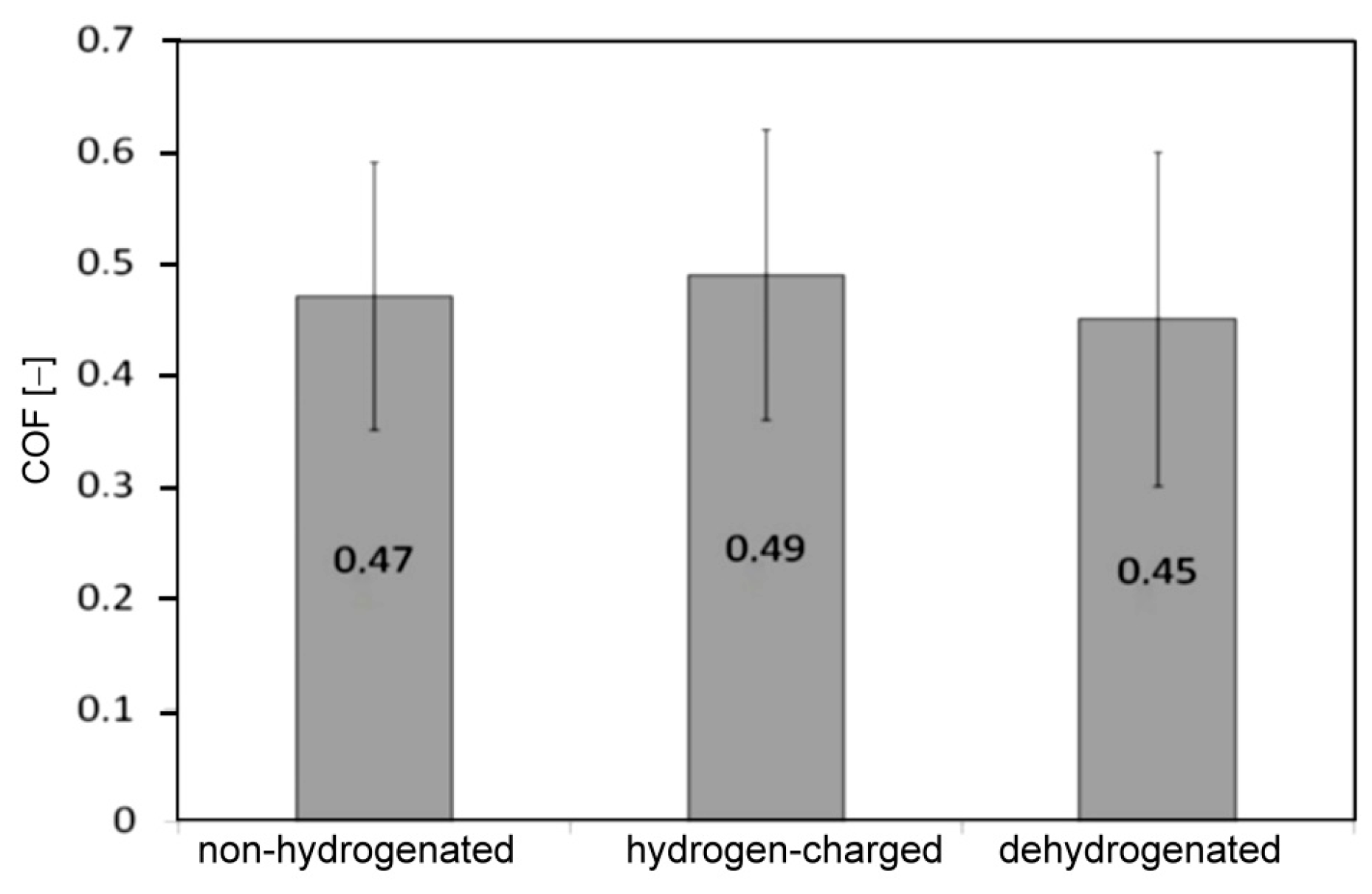

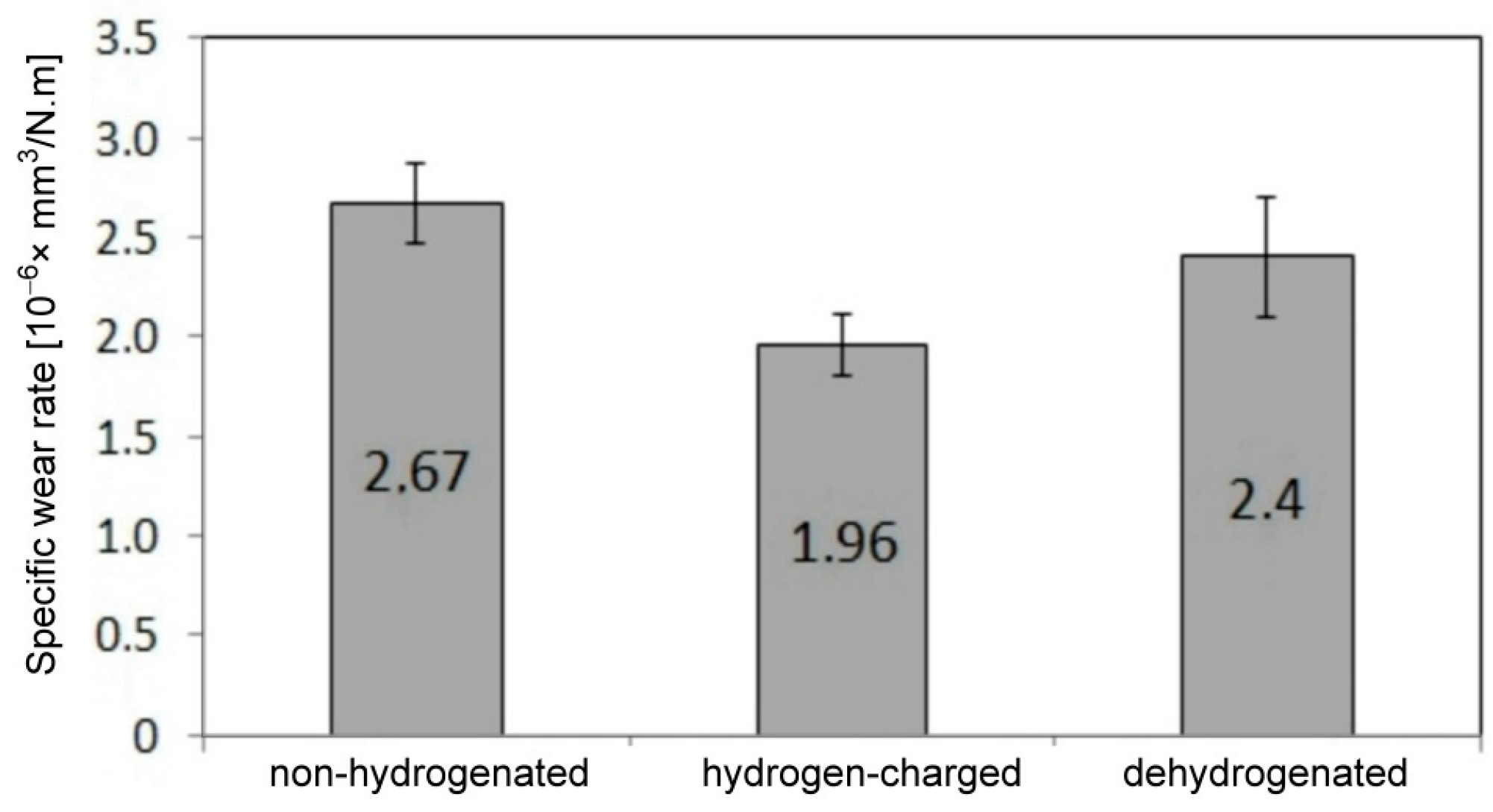
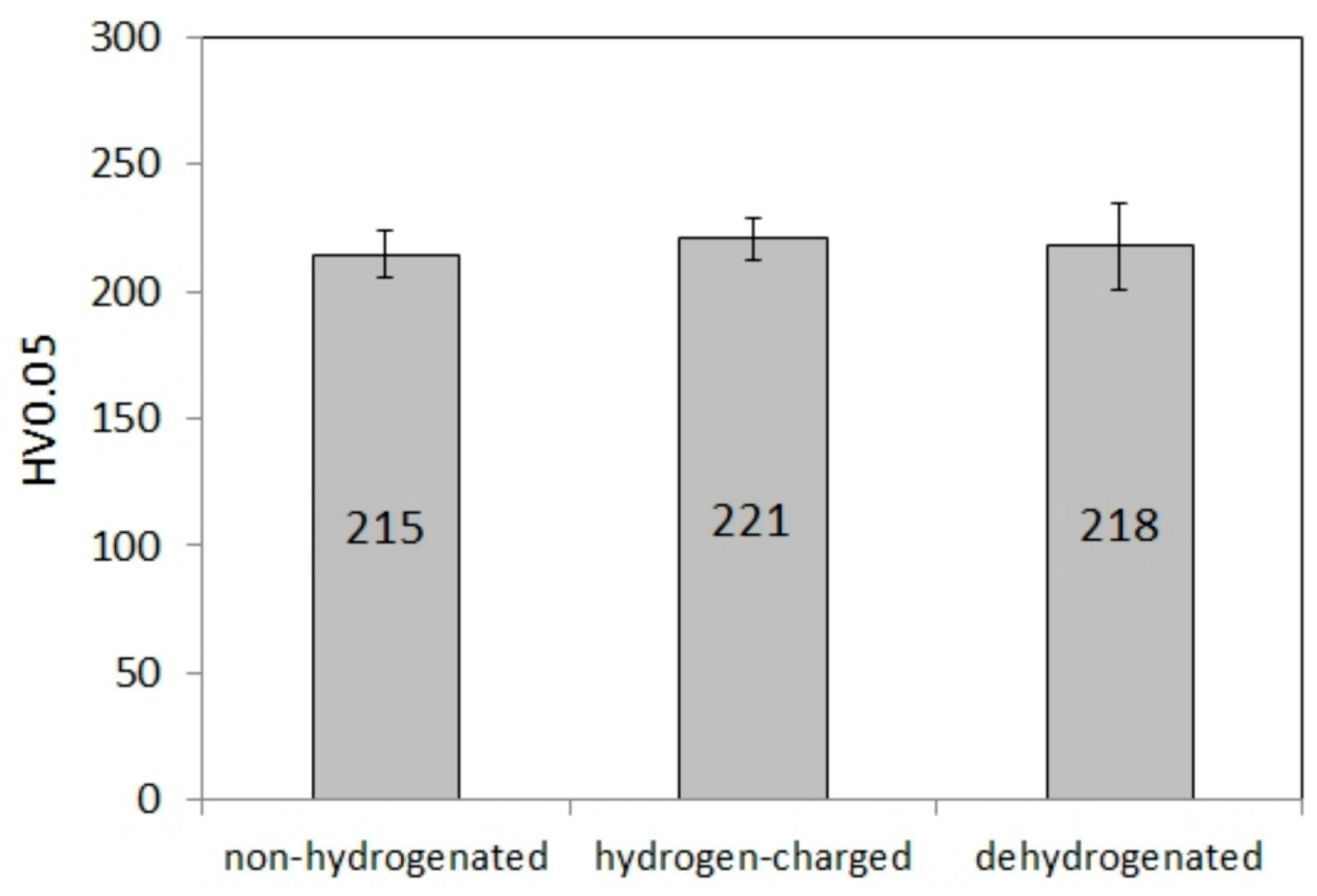

| Material | C | Si | Mn | Cr | Mo | Ni | Fe |
|---|---|---|---|---|---|---|---|
| AISI 316H | 0.05 | 0.51 | 1.77 | 16.76 | 2.05 | 11.13 | rest |
Disclaimer/Publisher’s Note: The statements, opinions and data contained in all publications are solely those of the individual author(s) and contributor(s) and not of MDPI and/or the editor(s). MDPI and/or the editor(s) disclaim responsibility for any injury to people or property resulting from any ideas, methods, instructions or products referred to in the content. |
© 2023 by the authors. Licensee MDPI, Basel, Switzerland. This article is an open access article distributed under the terms and conditions of the Creative Commons Attribution (CC BY) license (https://creativecommons.org/licenses/by/4.0/).
Share and Cite
Falat, L.; Čiripová, L.; Petruš, O.; Puchý, V.; Petryshynets, I.; Kovaľ, K.; Džunda, R. The Effects of Electrochemical Hydrogen Charging on Charpy Impact Toughness and Dry Sliding Tribological Behavior of AISI 316H Stainless Steel. Crystals 2023, 13, 1249. https://doi.org/10.3390/cryst13081249
Falat L, Čiripová L, Petruš O, Puchý V, Petryshynets I, Kovaľ K, Džunda R. The Effects of Electrochemical Hydrogen Charging on Charpy Impact Toughness and Dry Sliding Tribological Behavior of AISI 316H Stainless Steel. Crystals. 2023; 13(8):1249. https://doi.org/10.3390/cryst13081249
Chicago/Turabian StyleFalat, Ladislav, Lucia Čiripová, Ondrej Petruš, Viktor Puchý, Ivan Petryshynets, Karol Kovaľ, and Róbert Džunda. 2023. "The Effects of Electrochemical Hydrogen Charging on Charpy Impact Toughness and Dry Sliding Tribological Behavior of AISI 316H Stainless Steel" Crystals 13, no. 8: 1249. https://doi.org/10.3390/cryst13081249






